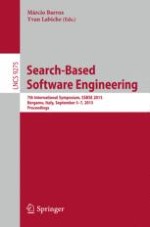2015 | OriginalPaper | Buchkapitel
Combining Multiple Coverage Criteria in Search-Based Unit Test Generation
verfasst von : José Miguel Rojas, José Campos, Mattia Vivanti, Gordon Fraser, Andrea Arcuri
Erschienen in: Search-Based Software Engineering
Aktivieren Sie unsere intelligente Suche, um passende Fachinhalte oder Patente zu finden.
Wählen Sie Textabschnitte aus um mit Künstlicher Intelligenz passenden Patente zu finden. powered by
Markieren Sie Textabschnitte, um KI-gestützt weitere passende Inhalte zu finden. powered by
Abstract
main method of a class; yet, a good unit test suite would consist of smaller unit tests invoking individual methods, and checking return values and states with test assertions. There are several different properties that test suites should exhibit, and a search-based test generator could easily be extended with additional fitness functions to capture these properties.